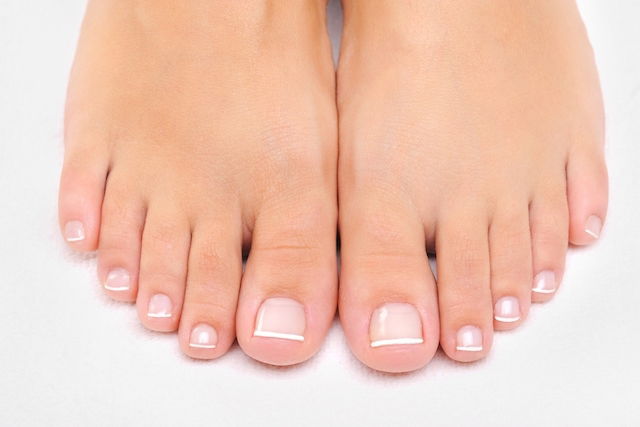An ingrown toenail can be treated at home if it is milk. You can try to lift the corner of the nail and inserting a small piece of absorbent cotton or gauze, so that the nail stops growing into the finger and eventually grows above the skin naturally.
However, sometimes these measures to treat ingrown toenails at home may not be sufficient, especially when the area around the nail is very red, swollen or filled with pus. These are signs of an infection in the area.
If you have an ingrown nail that presents with symptoms, you should see a doctor for assessment. The doctor may prescribe antibiotics if an infection is noted, and may recommend a procedure to remove the ingrown nail.

Step-by-step guide for ingrown nail treatment
To treat a slightly ingrown and inflamed toenail, follow these steps:
1. Soak your foot in warm water
First, soak the foot in warm water for 10 to 20 minutes. This will make the nail more pliable and help to relieve the pain.
2. Try to keep the ingrown part elevated
When the nail is more flexible, lift the ingrown corner with tweezers and place a small piece of absorbent cotton or gauze between the nail and the skin to keep it elevated. This allows the nail to grow out of the skin and also allows it to be cut properly.
3. Keep the area clean
Finally, you should apply an antiseptic solution, such as povidone iodine, to prevent the area from becoming infected.
Treatment options
Medical interventions for ingrown toenails that your doctor may prescribe include analgesics and/or anti-inflammatories to reduce inflammation, swelling and pain in the area.
The doctor may also prescribe are antibiotic ointments, such as neomycin and bacitracin, for example, if the ingrown toenail presents with pus or other signs of infection.
Surgical interventions
Surgery for an ingrown toenail is usually indicated for cases if an ingrown toenail with infection, recurrence of the ingrown toenail or when treatment by lifting the nail or cutting it off is not enough to solve the problem.
Surgery is usually performed under local anesthesia and, in most cases, it is not necessary to remove the entire nail. In some cases, the doctor may also choose to apply an acid, such as silver nitrate, which destroys part of the ingrown nail.
Home remedies
A good remedy for an ingrown toenail is to soak the affected foot in water with common salt or Epsom salt for about 20 minutes, as it helps to reduce swelling and inflammation, relieving pain.
Another option is to place your foot in a basin with warm water and 1/4 cup of apple cider vinegar, as it has anti-inflammatory and antiseptic effects, which can help alleviate symptoms.
What not to do
In you have an ingrown toenail, you should not cut off the ingrown part of the nail, cut the nail in a "v" shape or put a tight bandage on it. These measures may make the ingrown toenail worse and increase the risk of the nail becoming ingrown again.
When to see a doctor
You are advised to see a doctor if you have an ingrown nail and a history of:
- Diabetes
- Peripheral arterial disease
- Blood clotting problems
- Persistent ingrown toenail
- Presence of swelling, redness and/or pus
- Difficulty walking due to the ingrown toenail
In addition, if the nail becomes ingrown very often or persists for a long time despite treatment, it is important to have it assessed by a doctor, as a procedure to remove it may be necessary.
How to prevent ingrown nails
Some ways to prevent ingrown nails are:
- Avoid cutting nails too rounded or short
- Prefer looser shoes
- Changing socks daily
- Proper foot hygiene.
In addition, it is important to properly treat any other type of nail disease that you may have, like fungal nail disease.






























